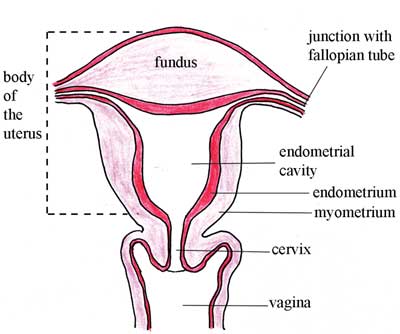3.4.2 The uterus
The uterus is a hollow, muscular organ in which a fertilised ovum becomes embedded and develops into a fetus. Its major function is protecting and nourishing the fetus until birth.
During pregnancy, the muscular walls of the uterus become thicker and stretch in response to increasing fetal size during the pregnancy. The uterus must also accommodate increasing amounts of amniotic fluid (the waters surrounding the fetus, contained in a bag of fetal membranes), and the placenta (the structure that delivers nutrients from the mother to the fetus). You will learn a lot more about this in Study Session 5.
Why do you think the muscular walls of the uterus become thicker during pregnancy?
A thicker layer of muscle has the strength to support the growing fetus and the other contents of the uterus, which get much heavier as pregnancy proceeds.
The uterus has four major anatomical divisions, shown in Figure 3.4:
- Body: the major portion, which is the upper two-thirds of the uterus.
- Fundus: the domed area at the top of the uterus, between the junctions with the two fallopian tubes.
- Endometrial cavity: the triangular space between the walls of the uterus.
- Cervix: the narrow neck at the upper end of the vagina.
The wall of the uterus has three layers of tissue, two of which are shown in Figure 3.4:
- The perimetrium: the outermost thin membrane layer covering the uterus. (It is not important for you to know this term for obstetric care.)
- The myometrium: the thick, muscular, middle layer in Figure 3.4.
- The endometrium: the thin, innermost layer of the uterus, which thickens during the menstrual cycle. This is the tissue that builds up each month in a woman of reproductive age, under the influence of the female reproductive hormones.
What happens to the endometrium if the hormones stop circulating after ovulation?
The blood supply to the endometrium is cut off, and it sheds from the body through the vagina as the monthly menstrual flow.
3.4.1 Fallopian tubes and ovaries

